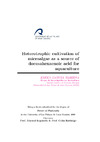Please use this identifier to cite or link to this item:
https://accedacris.ulpgc.es/jspui/handle/10553/2247
| Title: | Heterotrophic cultivation of microalgae as a source of docosahexaenoic acid for aquaculture | Authors: | Ganuza Taberna, Eneko | Director: | Izquierdo López, María Soledad | UNESCO Clasification: | 2401 Biología animal (zoología) 310906 Nutrición |
Keywords: | Peces Ácidos grasos Alimentación Cultivo Microalgas |
Issue Date: | 2008 | Abstract: | This thesis focuses on the development of new microbial sources of docosahexaenoic acid (22:6 n-3; DHA) and their implementation in aquafeeds. The supply of highly unsaturated fatty acids is one of the major challenges to be faced by the aquaculture industry, as it still depends on the fish oil obtained from wild fisheries to produce their feeds. Thus, the aim of the research is to develop and optimise a sustainable process integrating the production of this essential fatty acid from heterotrophic microorganisms and its implementation in fish microdiets. For this purpose, two marine microalgae, Schizochytrium G13/2S (Thraustochytrid) and Crypthecodinium cohnii (Dinoflagellida), were cultivated in fermenters under controlled conditions. In order to identify the relevant parameters of the proces for the production of DHA, special attention was paid to the study of the lipid accumulation physiology and biochemistry. Accordingly, several cultivation protocols were developed, analysed and optimised with respect to the production of biomass, lipid and DHA. The nutritional properties of the algal biomass in fish diet were investigated in seabream (Sparus aurata) larvae due to their well-known requirements for DHA. The nutritional performance upon fish oil replacement was evaluated in larvae dietary acceptance, growth, survival, stress tolerance and disease resistance, paying special attention on the fatty acid transformations and accumulation within the body. Chapter 3 describes how Schizochytrium G13/2S, coinciding with its capacity to store an intracellular nitrogen pool, was able to grow and accumulate lipids simultaneously. Under continuous culture, lipid accumulation was promoted with low nitrogen concentrations while maintaining glucose at saturating levels. In turn, carbon-limiting conditions in continuous culture did not impede lipid accumulation as expected from other oleaginous microorganisms. These characteristics showed that continuous culture, due to the good DHA productivities, as compared to those obtained in batch culture, probes encouraging for industrial consideration. In addition, the medium employed in continuous and fed-batch cultures inhibited the synthesis of 15:0 and 17:0 fatty acids, on behalf of other fatty acids (Chapter 5). This was associated to the lack of propionic acid precursors in glutamate or ammonium. On the other hand, the air supply improved growth and lipid accumulation in Schizochytrium G13/2S and C. cohnii but DHA proportion in fatty acid was not affected, suggesting that O2, often considered as the limiting nutrient in industrial fermentations, is not involved in the desaturation steps synthesising this fatty acid (Chapter 4). To conclude the microbial work, various fermentation strategies were developed for both organisms. Finally, optimum DHA productivities in Schizochytrium G13/2S and C. cohnii were attained in an ammonium/pH-auxostat (Chapter 6) and an ethanol (Chapter 7) fed-batch systems respectively. Schizochytrium G13/2S was at least twice productive than C. cohnii. Chapter 8 focuses on the effect of fish oil replacement by both algae (either homogenised or as a whole cell) in microparticulate diets for seabream. DHA incorporation by larvae was equivalent in all treatments indicating that microbial oils, even as a whole cell biomass, were good sources of DHA. Moreover, Schizochytrium provided n-6 docosapentaenoic acid, which might contribute to the increasing levels of the essential arachidonic acid by retroconversion. Dietary intake, growth, survival, stress response and disease resistance were not compromised by the dietary substitution of fish oil, however, the larvae growth performance decreased when both fish oil and lipids from the protein source in microdiets were substituted, suggesting that microbial eicosapentaenoic acid sources should also be implemented. | Description: | Programa de doctorado: Acuicultura: Producción Controlada de Animales acuáticos | Department: | Departamento de Biología | Faculty: | Facultad de Ciencias del Mar | Institute: | IU de Sanidad Animal y Seguridad Alimentaria | URI: | https://accedacris.ulpgc.es/handle/10553/2247 | ISBN: | 978-84-692-1838-9 |
| Appears in Collections: | Tesis doctoral |
Page view(s)
132
checked on Feb 17, 2024
Download(s)
868
checked on Feb 17, 2024
Google ScholarTM
Check
Altmetric
Share
Export metadata
Items in accedaCRIS are protected by copyright, with all rights reserved, unless otherwise indicated.
